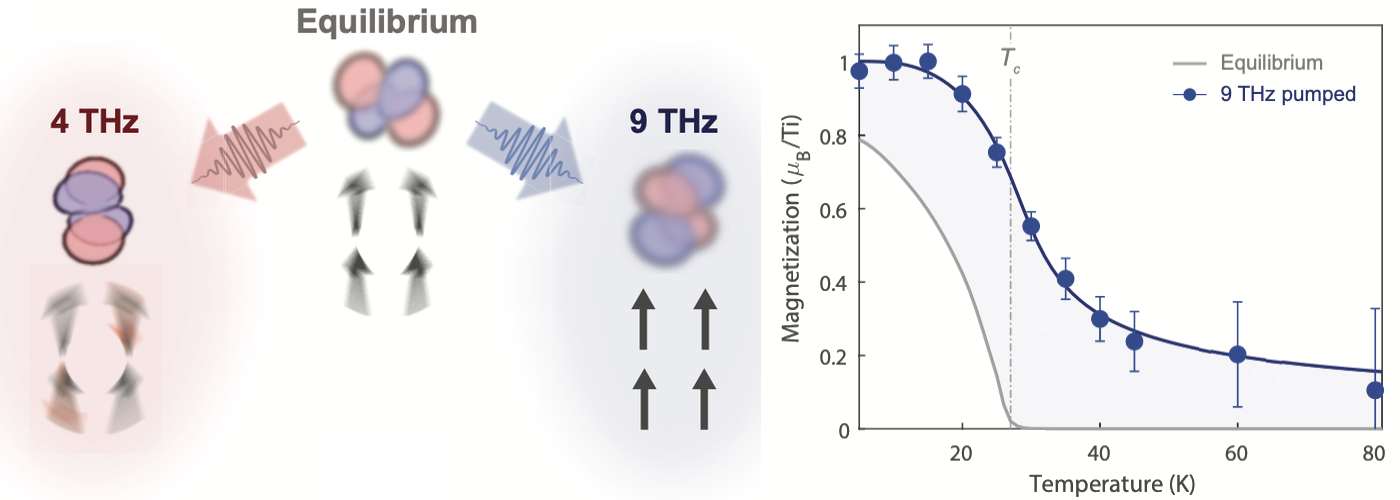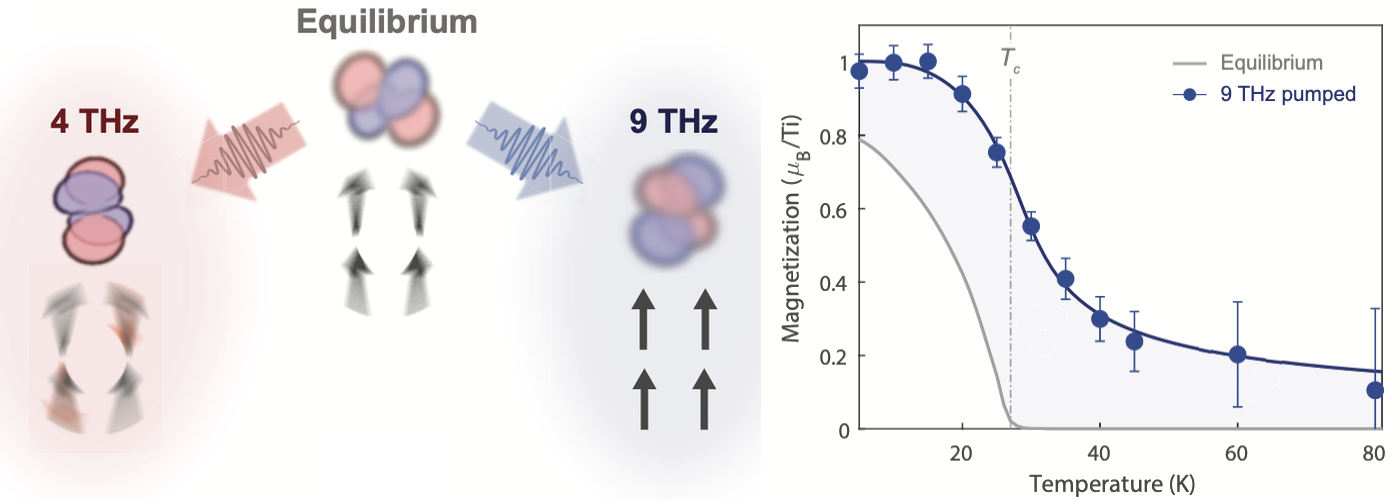Light Boosts Magnetism in a Crystal
Crystals of yttrium titanate are relatively feeble magnets. At zero K, tiny quantum fluctuations weaken the microscale alignment of electrons and spins that the material’s magnetism relies on. At 27 K, the magnetism disappears entirely. Now Andrea Cavalleri of the Max Planck Institute for the Structure and Dynamics of Matter, Germany, and his collaborators have used intense terahertz laser pulses not only to boost the magnetism of YTiO3 but to preserve it to a temperature higher than 80 K [1]. The method could enable researchers to make optically activated switches that either create or destroy magnetism. That ability, Cavalleri says, could ultimately lead to memory devices that can encode 0’s or 1’s at “higher speeds than ever before.”
The low-temperature fluctuations that suppress the magnetism in YTiO3 arise because the crystal alternates randomly among three different ground states. Those states, in turn, arise because the titanium atoms have a single valence electron that can choose from three different orbitals. As the crystal alternates among these degenerate states, any alignment between the valence electrons’ spins gets lost. “The name of the game is removing these degeneracies and making it so that only one of three orbitals is favored,” Cavalleri says. “Nature does not give you that.”
The current work springs from a 2007 study in which Cavalleri and his team reported using terahertz laser pulses to distort a lattice into favoring a particular ground state [2]. The pulses excited specific, quantized vibrations—phonons—that changed the electronic state of a crystal, yielding a transient drop in electrical resistance of 5 orders of magnitude.
In their new experiment, the researchers selected three laser frequencies that were separately coupled to one of several possible lattice distortions in YTiO3. Using a magneto-optical pump-probe setup, they examined how each of the excitations affected the crystal’s structure and its magnetism. Specifically, they observed whether the polarization of the light reflected by the crystal changed when viewed in opposite directions. A clockwise–counterclockwise shift in the polarization of the reflected light would be a sure sign of time-reversal invariance, which happens only in the presence of magnetic order.
They found that ultrafast laser pulses tuned to a phonon frequency of 9 THz caused the YTiO3 crystal to fully magnetize just above zero K. They then showed that this order, instead of vanishing at 27 K, remained stable up to at least 80 K, the highest temperature that they measured. What’s more, the magnetism persisted for many nanoseconds, 6 orders of magnitude longer than the femtoseconds-long laser pulses. The team attribute this long-lasting state to the stability of the structural distortions induced by energy deposited by the laser.
Achieving such an increase in the temperature at which spin order persists is “huge,” says Alexey Kimel, who studies ultrafast magnetism at Radboud University in the Netherlands. Other researchers using light-driven approaches to achieve order in magnetic semiconductors have reported temperature increases of around 1%. In contrast, Cavalleri and his colleagues achieve an increase of 300%. David Hsieh, who studies ultrafast control of quantum materials at the California Institute of Technology, notes that most previous efforts focused on suppressing or switching preexisting magnetic order. “The new work suggests that using light to suppress electronic fluctuations may be a general strategy to enhance electronic ordering tendencies in a material,” he says.
–Rachel Berkowitz
Rachel Berkowitz is a Corresponding Editor for Physics Magazine based in Vancouver, Canada.
References
- A. S. Disa et al., “Photo-induced high-temperature ferromagnetism in YTiO3,” Nature 617, 73 (2023).
- M. Rini et al., “Control of the electronic phase of a manganite by mode-selective vibrational excitation,” Nature 449, 72 (2007).





